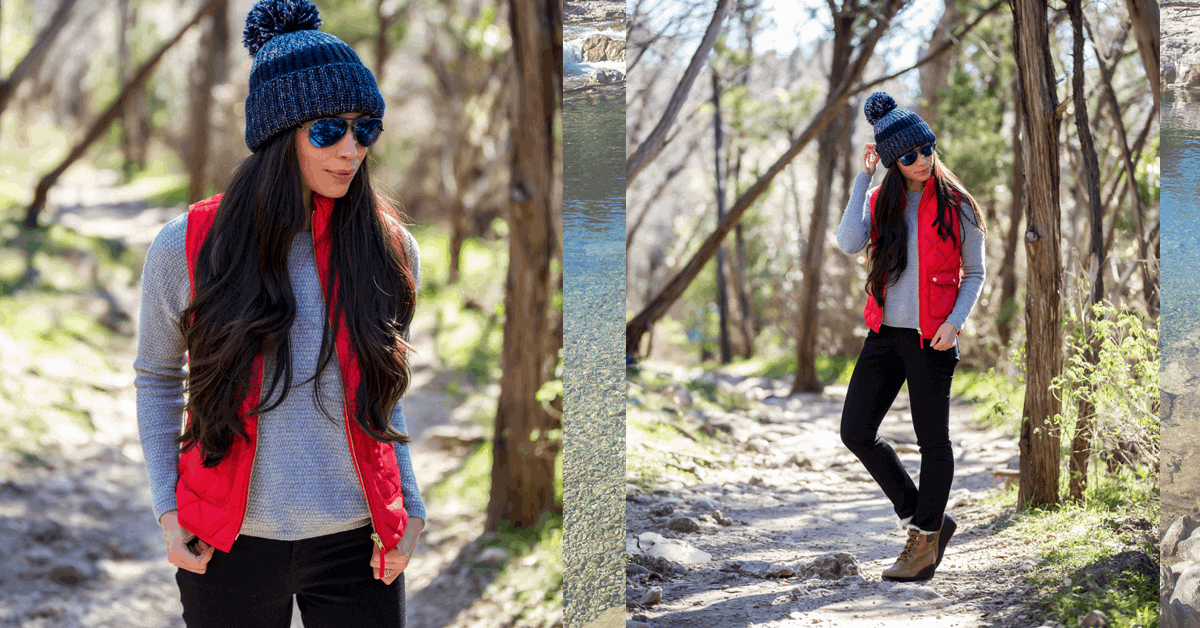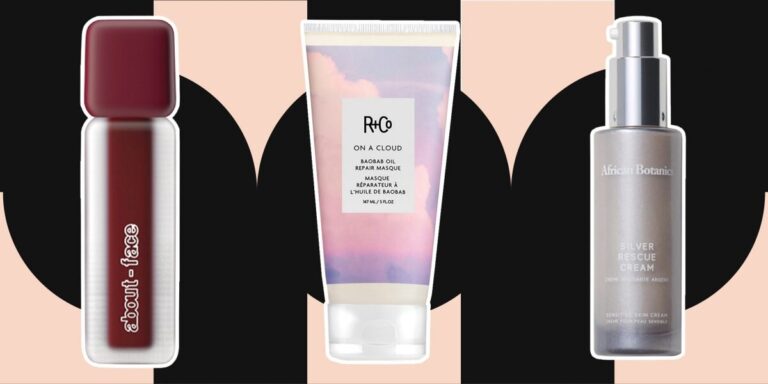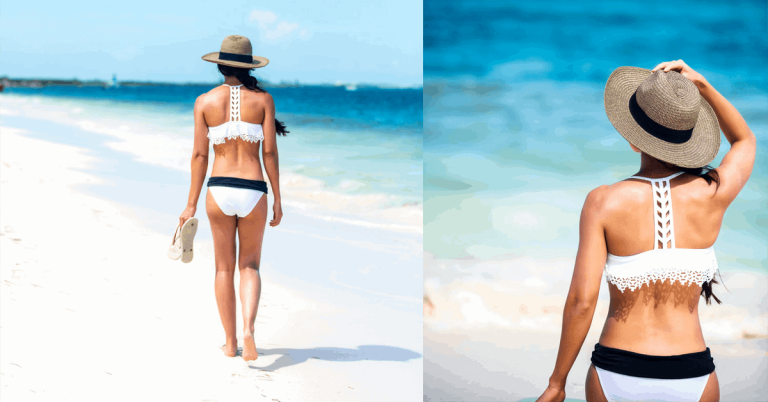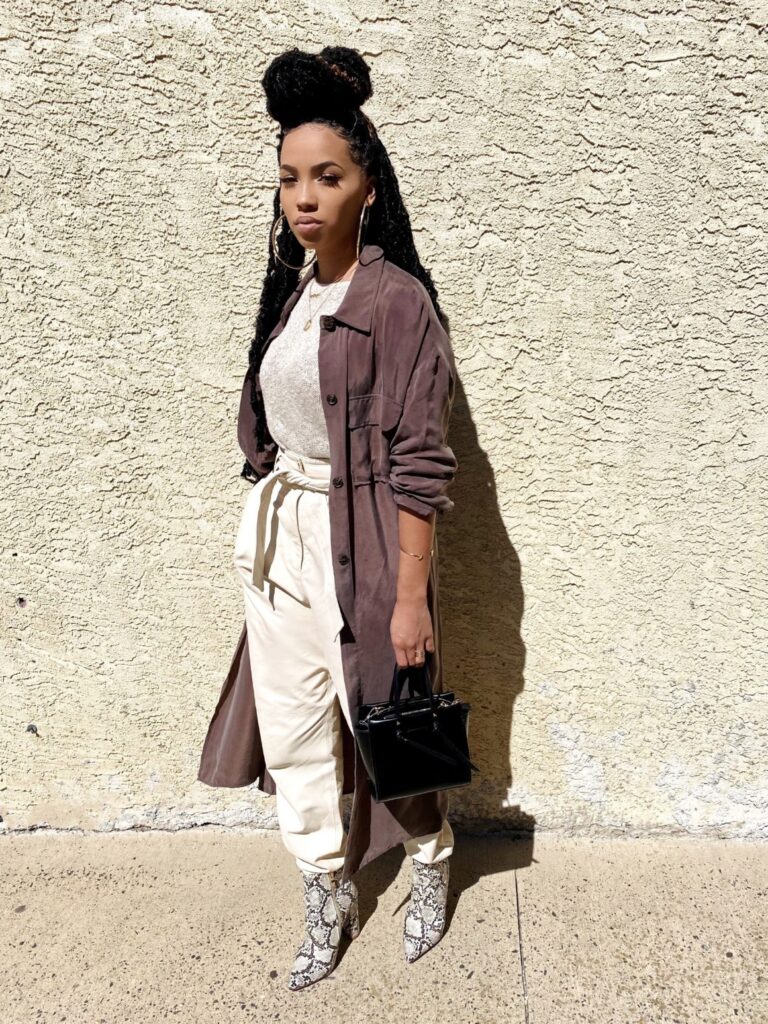Hiking in Style: Finding the Right Hiking Outfit for You

Peter and I love to get outdoors and wander. Sometimes this is at the ocean, amongst giant redwood trees or, in this case, the trails around Austin, Texas. We’ve recently moved to the Lone Star State, which provides plenty of new places to explore on foot. And there’s no reason you can’t get out into nature and look stylish at the same time, right?
A hiking outfit doesn’t have to be bulky, frumpy, or without color. Today’s materials include lightweight thermals, dry-fit tops to wick away sweat, flannel-lined pants for an extra layer of warmth, and stylish hiking boots to complete any ensemble.
Hiking Conditions Will Determine What to Wear Hiking
Your hiking outfit will depend upon your destination, the weather, and the length of your hike.
Hiking Destination
Are you heading out to a paved trail or a dusty hiking path? Will you be mucking through mud or trekking across rocky terrain or boulders? Taking it easy on a flat trail or climbing up and down a mountain? The answer to each of these will help to determine your hiking attire.
If you are on a nice level paved trail, then you probably won’t be exerting a lot of energy that will make you perspire and shed layers as you go. You also won’t need heavy-duty hiking boots.
If you will be crossing creeks or mucking through mud, you’ll want to make sure your hiking shoes are waterproof or at least water-resistant, and easy to clean. You’ll also need a good tread that grips and keeps you from falling. The length of your pants is also a consideration here, as longer pants will not only get wet, but also attract dirt and mud.
If you’re planning on an unpaved, dusty trail or hiking uneven or hilly terrain, you’ll need good ankle support, a good tread, and layers of clothing, so that you can peel a layer off if you get too warm.
Hiking Weather
Weather is a major consideration when planning your hike and your wardrobe. Dry and dusty is far different than pouring rain or encountering snowy pathways at the top of a mountain. You need to make sure that your hiking outfit reflects the temperature and weather conditions.
Rain and snow require warm layers, rain- or water-proof outerwear, and a good pair of waterproof boots with a good tread. A hat is also a must-have item, although the type will vary depending on whether you might encounter a downpour or freezing snow conditions.
In warmer weather, a few light layers is all that is required of a hiking outfit…and a hat to keep the sun off your face and neck. Depending on the region, you may opt for shorts or pants. Even in hot, humid weather your hiking outfit should contain long pants if there are plentiful bugs, poison oak or ivy, or a large amount of low brush that could do damage to your legs.
Length of Hike
A one-hour stroll along an ocean bluff requires far different hiking apparel than an 8-hour trek in the mountains. You can get away with stylish athletic shoes or walking shoes for the former, but will need well-fitting hiking shoes for the longer journeys.
Pockets and backpacks are not so essential for easy, short forays, while both come in handy when going out for longer periods of time. In addition to the requisite keys, phone, and water bottle, on long hikes you’ll need room to stow away sunscreen and/or bug spray, snacks or a meal, tissues (for that pit stop you know you’ll need), and other small essentials. And if you’ll be peeling off or adding layers as you go, the extra room of a pack will be a welcome relief.
Now it’s time to get down to the nitty gritty….
Putting Together a Stylish & Appropriate Hiking Outfit
Let’s start from the top and work our way down. I’m offering up both practical and stylish hiking clothes that will protect you from the element and look good at the same time. You never know who you’ll run into on that hiking trail!
The Right Hiking Hat
No matter the weather, a hat is usually a necessary option. When it’s sunny, you need to be protected from the strong rays; rain requires something to keep your head dry; and snow necessitates a warm hat that covers both head and ears.
I prefer to stay away from baseball caps, as they don’t protect my neck in any way. For sun protection, you can done a nice Panama hat, floppy straw hat, summer fedora, or check out some stylish ways to wear a hat in my hat guide, they might not all work for hiking but you’ll get some outfit ideas.
When it comes to rain, you are bit more limited style-wise. L.L. Bean has three good options, or be a bit more unconventional and wear this Oilcloth Outback Hat from Orvis (designed for men, but we can make it work, I wear Peter’s hat all the time).
For colder climates and snow, you’ll want something to keep your head and ears warm. And there are sooooo many fun, colorful and stylish choices to wear with your hiking outfit! I’m wearing a ribbed knit beanie in blue and gray (to match the top and sunglasses!). You can find similar beanies major department stores, just make sure they are not only stylish but keep your head warm! Here are a lot of cute options. Look for cuffed beanies, cable-knit beanies, or try this Yukon Cap. I love the fleece lining and the convertible earflaps!
shop hiking hat
Different Types of Hiking Base Layers
Your hiking outfits should always start with a base layer. For warmer climates, this will be a tank or short-sleeved tee in cotton or a dry-fit type of material. Pull one from your existing closet, or check out the SmartWool NTS Micro 150 T-Shirt or Craft Active Comfort RN Base Layer, or the Nike Pro Hypercool Tank. (love the pink color!)
For colder climates, you’ll want something more form fitting on the top to keep the warmth in. A long-sleeve tee or turtleneck made from a natural material (silk or wool) or one of the newer cold-rated synthetic materials are best. Good examples of warmer base layers are ROJK Superwear Roamer Pullover Hoodie, the Capilene Midweight Crew Neck by Patagonia, and this fun Kari Traa Rose Half-Zip from REI.
In my hiking outfit, I chose a gray thermal crew-neck, considered more of a mid-weight material. The weather that day in Austin was neither hot nor freezing, so it worked perfectly with the red quilted down vest for our hike.
Hiking Top Layer(s)
There are varying degrees of top layers, all appropriate for different temperatures. When Austin gets hot in the summertime, I might add a thin, long-sleeve button-down shirt over a tank, so that my arms have protection from the sun’s hot rays. Here’s an example of a summer hiking outfit I wore when hiked around near Bass Lake in California.
In more moderate weather, I might swap out the button-down for a yoga half-zip, windbreaker, or lightweight fleece. Or, start with the button-down shirt and add a down vest, like the red one I am wearing here.
As the temperatures drop, however, your winter hiking outfit will need more and more layers over your base. I like the idea of the half-zip, either in a thinner dry-fit material or fleece. The higher neck keeps cold air from going down my shirt, and if you get warm, it can be unzipped for ventilation. Then you can layer on either a down vest or down jacket.
If it’s raining, or you anticipate rain, you can either swap out the down topper or add a water-resistant shell layer, like this Joules Coast Jacket or The North Face Venture Jacket. I also like the idea of this 3-in-1 jacket from The North Face, which has a breathable shell and quilted, insulated inner layer. You can wear both layers together for warmth and rain protection, or wear each separately.
shop hiking jacket
Hiking Pants or Shorts
As I mentioned before, the weather, the terrain, and the bug/plant population of your hiking trail will dictate whether your hiking outfit consists of shorts or pants.
Shorts are cooler than their longer counterparts and have a definite advantage in warm weather. If you opt for shorts, stick with a cotton, linen, or quick-drying fabric in a length suitable for bending over (no short-shorts). Tight shorts can mean uncomfortable chafing, so look for a pair that is fitted in the waist and hip but flares out a bit at the leg. Cuffs and pockets are optional.
If the weather is warm but you need or want to wear long pants, stick with a lightweight material instead of heavy denim. Columbia Saturday Trail II Convertible Pant turn into shorts! and Columbia Trail Pants are stylish and basic options, as are these Kuhl Mova Pants in Raven blue, which are soft and stretchy.
I’m actually wearing black denim jeans for my hiking outfit, nothing too fancy or too utilitarian. They have some stretch for comfort and kept me warm on this semi-chilly day. You could actually swap them out for colored denim or even traditional blue denim when the weather stays above 45-50 degrees. Leggings could also be a stylish option. I’ve got several pair of colorful yoga leggings that have served me well on hikes and walks.
For colder weather, you can start with silk or dry-fit long underwear or tights, and layer on warmer pants. Denim jeans, cotton twill, and lined pants are all good options. Make sure that the fit is not too tight for bending and climbing. Keep the length at least an inch from the ground (or you’ll end up with some filthy hems!).
shop hiking pants and shorts
Cute Hiking Boots and Shoes
First rule is to make sure that your shoes or boots are comfortable, provide good support, and are appropriate for the condition of the trail. We’d also like them to be stylish, if possible!
You have your choice of hiking boots, hiking shoes, and even walking or athletic shoes. The shoe you choose will be dictated by the weather conditions, terrain, and length of your hike.
Hiking boots come in both mid- and high-top versions. These are a more utilitarian style of boot for more active, long hikes, but that doesn’t mean you can’t look at least a little bit stylish while on the trail! Brands like Keen, Merrell, and La Sportiva have added some flair and color to what used to be a bland and boring tan or brown boot. Opt for an ankle-high boot when you’ll be tackling rough terrain, and make sure your boots are weatherproof if heading out to a wet or muddy trail.
The shoes I’m wearing here are more of a fashion boot than true hiking boot, but they worked perfectly on this slightly uneven and rocky trail. More versatile than your typical boot, mine have a slight wedge, giving me an extra inch and they are fur-lined for extra warmth, they are from Sperry. Bonus: They are nice enough to head to brunch after the hike!
If you prefer a low-top, go with a hiking shoe. Construction is similar to that of a hiking boot, but without any ankle support. Many are weatherproof for rainy and light muddy conditions, and they are appropriate for both paved and dirt trails.
For less strenuous and shorter trail hikes, look at trail runners, walking shoes or even a good athletic shoe with appropriate sole. Trail runners are a hybrid between a low hiking shoe and a running shoe, with a cushioned platform and special sole to work on both urban and trail environments. Salomon, Merrell and Vasque all make great women’s trail runners that have color and style interwoven with a practical design.
For urban trails, paved trails, or unpaved trails that are fairly level, walking and athletic shoes are appropriate. Yes, you can reach into your closet and pull out your Nikes for a trail walk, but leave your Sam Edelmans and Converse at home. Flat soles, like those of fashion sneakers, Keds, tennis and basketball shoes are not great for hiking. You need a well-padded footbed with a flexible ridged sole. Remember, those are the only feet you’ll ever have, so don’t abuse them in the wrong shoes!
shop hiking boots and shoes
Note: Boots and shoes should be worn with socks; either cotton, wool, or some type of quick-drying synthetic material is best. Many experienced hikers wear two pair to help protect feet and prevent blisters. Try a thin pair of cotton socks with a heavier wool sock over, particularly in colder climates.
So, are your ready for a hike? Did you find some cute hiking outfits or pieces that will work for you? Let me know how it goes!
Stay Stylish
—V






